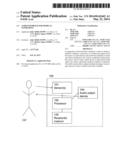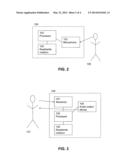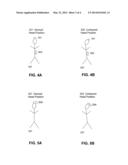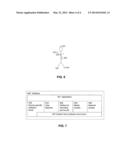Patent application title: Audio Feedback for Medical Conditions
Inventors:
Judy Sibille Snow (Los Altos, CA, US)
Robert James Snow (Los Altos, CA, US)
IPC8 Class: AA61B500FI
USPC Class:
600485
Class name: Diagnostic testing cardiovascular measuring pressure in heart or blood vessel
Publication date: 2014-05-22
Patent application number: 20140142442
Abstract:
An apparatus is disclosed that comprises a sensor to detect a medical
condition; a processor to evaluate the signals from the sensor; an input
device and read/write medium to record cues that correspond to the
various condition(s) detected by the sensor; and an audio output device
to play prerecorded audio cues when a particular medical condition is
detected. The audio cue provides a unique reminder message to encourage a
person to take a certain action that is healthy.Claims:
1. An apparatus for monitoring one or more medical conditions in a human
patient, and for providing essentially immediate feedback concerning the
one or more medical conditions to the patient; said apparatus comprising
one or more sensors, a processor, a read/write medium, and an audio
output device, wherein: (a) said one or more sensors are adapted to make
one or more measurements that pertain to one or more medical conditions
in the patient; and to output the one or more measurements to said
processor; (b) said processor is programmed to correlate the one or more
measurements from said one or more sensors to the presence or absence of
one or more medical conditions in the patient; and to command said
read/write medium to transit one or more audio cues to said audio output
device when one or more medical conditions are detected; (c) said
read/write medium is adapted to store one or more audio cues that are
input from a source; and is adapted to transmit one or more audio cues to
said audio output device upon command from said processor; (d) said audio
output device is adapted to play the one or more audio cues so that the
patient hears the one or more audio cues, and the patient thereby
receives feedback concerning the one or more medical conditions; and (e)
said apparatus is adapted and programmed thus to provide audio cue
feedback to the patient when one or more medical conditions are present
with essentially no delay.
2. The apparatus of claim 1, additionally comprising a microphone adapted to transmit an audio cue provided by a user to said read/write medium to be stored by said read/write medium; wherein the user may be the patient, or the user may be someone other than the patient.
3. The apparatus of claim 1, wherein said processor is additionally programmed to log measurements from said sensors onto said read/write medium for further analysis.
4. The apparatus of claim 3, wherein said processor is additionally programmed to conduct the further analysis of the logged measurements; and wherein the further analysis comprises a comparison between different alternative audio cues to determine which audio cues result in better patient compliance, and the subsequent optimization of the audio cues to optimize patient compliance.
5. The apparatus of claim 3, wherein said processor is additionally programmed to present the logged measurements in a form convenient to be viewed and analyzed by a human operator; and to accept input from the human operator to alter the one or more audio cues in order to optimize patient compliance; wherein the operator may be the patient, or the operator may be someone other than the patient.
6. A system comprising the apparatus of claim 3, and a computer that is physically separate from said apparatus; wherein said system is adapted to transmit the logged measurements from said read/write medium to said computer; and wherein said computer is programmed to process the logged measurements for visual analysis or otherwise to make the logged measurements available for analysis by medical personnel.
7. The apparatus of claim 1, wherein the one or more medical conditions that said apparatus is adapted to monitor comprise an undesirable head position.
8. The apparatus of claim 1, wherein the one or more medical conditions that said apparatus is adapted to monitor comprise an undesirable gait.
9. The apparatus of claim 1, wherein the one or more medical conditions that said apparatus is adapted to monitor comprise one or more nervous habits.
10. The apparatus of claim 1, wherein the one or more medical conditions that said apparatus is adapted to monitor comprise a combination of a drop in blood pressure and an undesirable head condition, indicating that the patient is in danger of fainting or falling.
Description:
CROSS-REFERENCE TO RELATED APPLICATIONS
[0001] This application claims priority under 35 U.S.C. §119(e) from U.S. Provisional Application Ser. No. 61/727,800, filed Nov. 19, 2012, entitled "Audio Feedback for Medical Conditions," the contents of which are fully incorporated by reference herein.
TECHNICAL FIELD
[0002] This invention relates to the field of applications designed to monitor and provide audio feedback for human medical conditions.
BACKGROUND ART
[0003] Some people have a medical condition that is exacerbated by physical conditions. For example, some people look down habitually when they walk. This is especially noticeable in people who develop osteoporosis because their neck no longer straightens, and it is easier and more natural for them to look down. Physical therapists encourage patients to keep their head up to prevent them from getting dizzy. The consequences of dizziness can be serious, such as a fall resulting in a broken bone.
[0004] Recordable greeting cards have been disclosed (e.g., EP0207258A1 to Weigl, D580488 to Zarffis), as have a plethora of medical sensors. Some of these sensors may emit vibrations or sounds. A Lumoback product (webpage visited Nov. 16, 2012), http://www.lumoback.com/?x=saying, comprises a belt that is worn around a patient's abdomen, and that provides vibrations when the patient's lower back slouches, reminding the patient to stand up or sit up straight.
[0005] Unfortunately, the physical therapist isn't always with the patient who needs a reminder in response to a physical condition, such as to lift the head up. Although a vibration could be useful for as a reminder for a single condition, a vibration does not readily differentiate among various multiple physical conditions.
[0006] There is an unfilled need for an improved device which can both detect certain medically significant conditions and provide enhanced real-time feedback to the user to inform them of the detected medical condition, with the flexibility of providing different cues when the detected conditions are different.
DISCLOSURE OF THE INVENTION
[0007] We have discovered an apparatus that comprises a sensor to detect a medical condition, or more generally a body measurement of any type, for example a condition related to the movement or position of the body or part of the body of an individual; a processor to evaluate the signals from the sensor; an optional microphone; a read/write medium to record audio cues that correspond to the various conditions detected by the sensor; and an audio output device to play prerecorded audio cues to provide immediate feedback when a particular medical condition is detected.
[0008] The elements of the apparatus need not be physically connected, but can be configured as discrete electronic devices inter-connected via wired or wireless techniques known in the art, for example infrared signals, or radio frequency (RF) signals such as Bluetooth.
BRIEF DESCRIPTION OF THE DRAWINGS
[0009] FIG. 1 illustrates schematically one embodiment of the invention.
[0010] FIG. 2 illustrates schematically one embodiment of a person recording one or more audio cues for the patient.
[0011] FIG. 3 illustrates schematically a patient being monitored by a sensor and receiving audio cues in accordance with one embodiment of the invention.
[0012] FIGS. 4A and 4B illustrate schematically an example configuration with two discrete physical devices for detecting a desirable and undesirable physical condition of a patient's head position.
[0013] FIGS. 5A and 5B illustrate schematically a second example configuration with one discrete physical device for detecting a desirable and undesirable physical condition of a patient's head position.
[0014] FIG. 6 illustrates schematically an alternative embodiment having multiple sensors, for example for detecting a patient's head position, hand position, blood pressure, and gait.
[0015] FIG. 7 illustrates schematically one embodiment of software architecture for a system to support the novel device.
MODES FOR CARRYING OUT THE INVENTION
[0016] As illustrated in the embodiment depicted in FIG. 1, system 100 comprises sensor(s) 101, processor 102, microphone 103, audio output device 104 and read/write medium 105. One or more sensor(s) 101 can detect motion, position, or other body measurements and can be used or positioned in a variety of ways. The processor 102 can be single, multi, or parallel. The read/write medium 105 can be RAM, flash, solid state, hard disk, virtual cloud storage, or other storage means. The optional microphone 103, and the audio output device 104 can be single or multi, mono or stereo, etc. The components in this configuration can be located in one or more physical packages. Connectivity can be wired, wireless, or virtual.
[0017] One embodiment to record audio cues is shown in FIG. 2. Any person 106 can record cues using a microphone 103 and a processor 102 that is capable of storing the message on a read/write medium 105. The cues can be arbitrary, but it is preferred that the recordings be appropriate to the medical conditions of the specific patient. It can direct the patient 107 with specific instructions, such as "Lift your head up!" In addition, the recording can be in the patient's language of choice. An unexpected benefit is that the person who makes the recording can be a person, such as a grandchild, whose voice recording may be able to cue the patient in an especially motivating and positive way. The processor 102, microphone 103, and read/write medium 105 can be located in a single physical package or can be contained in multiple discrete packages and inter-connected electronically using any one of a number of well-known physically wired, wireless, or virtual connections. In an alternative embodiment, the system does not include a microphone. The audio cues may be recorded externally through means known in the art, for example with a voice recorder or a computer equipped with a microphone, and file(s) containing externally-recorded audio cue(s) may be uploaded to the system.
[0018] FIG. 3 shows one embodiment to monitor a patient 107 with sensor(s) 101. The sensor(s) 101 can be physically attached to the patient 107, or can be a remote sensor, such as a camera monitoring the patient. A processor 102 interprets data from the sensor(s) 101 and determines whether at least one medical condition is met. The medical condition can be an unhealthy change in position, pattern of motion, or other measurable body data. Multiple medical conditions can be simultaneously addressed. FIG. 6 shows an example employing multiple sensors 101: if the patient's blood pressure is detected to drop at the same time that her head position drops, she can be told to "Lie down!" to prevent a fall. Referring back to FIG. 3, the processor 102 then selects the appropriate cue from a read/write medium 105 and plays the cue on an audio output device 104 such as a speaker or headset. The sensor(s) 101, processor 102, read/write medium 105, and audio output device 104 can be located in a single physical package or can be contained in multiple discrete packages and inter-connected electronically using any one of a number of well-known physically wired, wireless, or virtual connections.
[0019] In an alternative embodiment, rather than an audio cue an output device generates another type of feedback signal, such as a buzz, vibration, light, etc.
[0020] FIGS. 4A and 4B illustrate one embodiment, where a sensor 101 is attached to a hat worn on the patient's 107 head, and the rest of the hardware is contained in a package 303 attached to the patient's belt. The desired head position 301 of the patient 107 is looking straight ahead. The medical condition being detected is when the head drops or looks down, as shown by the undesired head position 302. In this example, the processor 102, microphone 103, audio output device 104, and read/write medium 105, can all be contained in an Android device or other smartphone 303, and the sensor 101 comprises an accelerometer connected wirelessly, e.g. by Bluetooth.
[0021] FIGS. 5A and 5B illustrate an alternative embodiment, where all hardware is in a single package 304 attached to a hat worn on the patient's 107 head. The desired head position 301 of the patient 107 is looking straight ahead. The medical condition being detected is when the head drops or looks down, as shown by the undesired head position 302. In this example, the accelerometer sensor, processor, microphone, audio output device, and read/write medium are all contained in one physical package 304, attached to patient 107's hat. In this configuration, the one package 304 could be a device running iOS, such as an iPhone. Additional embodiments could incorporate other custom or off-the-shelf hardware components in a variety of configurations and complexity.
[0022] Example. A working device configured as depicted in FIG. 4 has been built and successfully tested to monitor and provide feedback for a patient's head position. The patient 107 showed increased compliance in keeping his head up while walking He was much more motivated hearing his grandchild's voice in a recording, rather than another adult, such as his daughter, whom he perceived as "nagging".
[0023] In accordance with the present invention there are many additional examples of uses for sensor(s) 101 that could detect movement or position of a patient's body or body part with an accelerometer as shown in FIG. 6. For example, a sensor 101 attached to a shoe could detect a person who is dragging her foot; a medical condition that can result in tripping. A person with nervous habits such as biting their fingernails or pulling their hair (trichotillomania) could have a sensor 101 that would detect hand movements that encompass the undesired behavior. A patient could benefit from feedback on various nervous habits that might or might not rise to the level at which the nervous habits would be considered a "medical condition." Such a nervous habit is nevertheless considered a "medical condition" for purposes of this disclosure, unless context clearly indicates otherwise.
[0024] FIG. 7 illustrates the components of the operating software or firmware 400 for one embodiment of the invention. The software 400 comprises the system-level software and drivers 401 for whichever physical embodiment is selected. Upon this software or firmware, a layer of software exists that can be used by the application 406 in a variety of ways as described herein. Standard utilities for recording and sound 403 are typically available in a computer system to support input from a microphone 103 for audio recording and output to an audio output device 104. A device-specific software stack 401 for a specific sensor 101 may be available commercially or through open source, or an application developer can add specific code for a particular sensor.
[0025] In one embodiment, the application 406 detects a physical condition based on a signal from the sensor(s) 101, selects the appropriate audio cue, and sends it to the audio output device 104. In an expanded embodiment, the application can also use the user features 402 of a system to implement a display showing a record of progress for the patient 107 for each sensor 101, while logging this data on the read/write medium 105. One unexpected result of using this expanded embodiment is that we have found that the audio cues can be optimized for the individual patient, based on the record of that patient's past performance or results. A second unexpected benefit is that the logged data can be exported or transmitted via standard network access 406, to other computers for analysis or distribution to medical providers, e.g., via the cloud.
[0026] The complete disclosures of all references cited in this specification are hereby incorporated by reference. In the event of an otherwise irreconcilable conflict, however, the present specification
User Contributions:
Comment about this patent or add new information about this topic:
| People who visited this patent also read: | |
| Patent application number | Title |
|---|---|
| 20140142393 | MULTI-LUMEN-CATHETER RETRACTOR SYSTEM FOR A MINIMALLY-INVASIVE, OPERATIVE GASTROINTESTINAL TREATMENT |
| 20140142392 | SURGICAL ACCESS ASSEMBLY WITH SLEEVE AND ADJUSTABLE FASTENER |
| 20140142391 | MEASUREMENT PROBE |
| 20140142390 | Adapter To Couple A Mobile Phone To An Endoscope |
| 20140142389 | SEPARABLE TYPE ENDOSCOPE |





